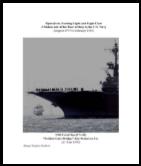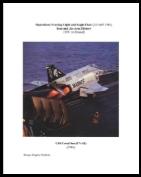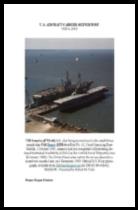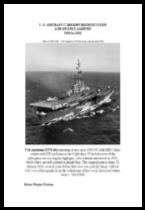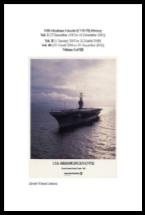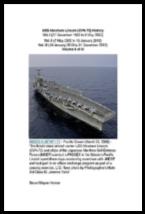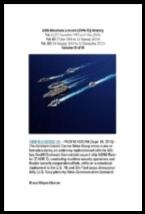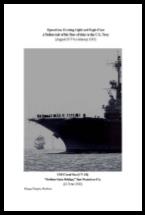






|
CHAPTER VI to IX (4 January to 8 January 1952) |

|
Good image of Midway as designed/completed. She would look nothing like this at the end of her career, modified into a totally different ship. (Looks like Navy Day parade image.) Battle Carrier Air Group (CVBG) 1 on deck. L. Russell Porter notes: "The photo [...] was taken [...] on arriving in Gibraltar, 47–48 cruise to the Med. I have an original of that photo and I was there, and it was dress ship. I was a printer working in print shop at this time printing the 'Midway Current' - NS024109 - Scott Odell, (MM3 USN-RET)." http://www.navsource.org/archives/02/024109.jpg
|
|
A Sailors tale of his Tour of duty in the U.S. Navy (August 1977 to February 1983) Operation Evening Light and Eagle Claw - 4 April 1980
Book - ISBN NO. 978-1-4276-0454-5 EBook - ISBN NO. 978-1-329-15473-5
Operations Evening Light and Eagle Claw (24 April 1980) Iran and Air Arm History (1941 to 1980)
Book ISBN NO. xxxxxxxxxxxxx EBook ISBN NO. 978-1-329-19945-3
U. S. AIRCRAFT CARRIER SHIP HISTORY (1920 to 2019)
Book - ISBN NO. 978-1-4276-0465-1 EBook - ISBN NO. 978-1-365-25019-4 Library of Congress Control Number: 2008901616 (Book Version)
U. S. AIRCRAFT CARRIERS REDESIGNATED AND OR RECLASSIFIED (1953 to 2016)
BOOK - ISBN NO. 978-1-4276-0452-1 EBook - ISBN NO. 978-1-365-25041-5 Library of Congress (Book Version) 2008901619
ENERGY QUEST AND U. S. AIRCRAFT CARRIER DEPLOYMENT HISTORY INVESTMENT CAPITAL REQUIRED TO PUBLISH 55 EIGHTH HUNNDRED PAGE BOOKS, EBOOKS & CD’s (48 Navy Books)
Book - ISBN NO. To Be Announced EBook - ISBN No. 978-1-365-26038-4
USS Abraham Lincoln (CVN-72) History Vol. I of III (27 December 1982 to 6 May 2003)
Book Vol. I of IV ISBN: TBA EBook Vol. I of IV ISBN: 978-1-365-73794-7
USS Abraham Lincoln (CVN-72) History Vol. II of III (7 May 2003 to 13 January 2010)
Book - ISBN NO. To Be Announced EBook - ISBN NO. 978-1-365-74027-5
USS Abraham Lincoln (CVN-72) History Vol. III of III (14 January 2010 to 31 December 2012)
Book - ISBN NO. To Be Announced EBook - ISBN No. 978-1-365-74145-6
USS Coral Sea CV-42 CVB-43 CVA-43 and CV-43 History and Those Aircraft Carriers Operating with Coral Sea During Her Tour of Service CONSTRUCTION to LAUNCHING and EARLY JET AIRCRAFT DEVELOPMENT (10 July 1944—2 April 1946) and a Tour of Duty in the U. S. Navy (August 1977 to February 1983)
ISBN: 9781434382917
|
|
Second Mediterranean Sea deployment (4 January to 5 March 1949) and Operations 6 March to 30 October 1949 included a cruise to the Panama Canal; carrier qualification landings for Air Group Eight off Jacksonville, Florida, and fleet maneuvers while based at Guantanamo Bay and off New York. (4 January to 30 October 1949) CHAPTER VI
“USS Midway (CVB-41) with Rear Admiral John Jennings Ballentine, U.S.N., Commander Carrier Division One and Commander, Carrier Air Group Seventeen (CVBG-17) embarked departed Norfolk Va. 4 January 1949, with Captain Marcel Emil Adan Gouin, USNA ‘24, as Commanding Officer, on her second Mediterranean Sea deployment operating with the 6th Fleet, steaming through the Atlantic, operating with the U.S. Atlantic Command (USLANTCOM) (Atlantic Fleet), operational control extending to the Second Task Fleet and ComAirLant to the Mediterranean Sea, with two Marine fighter squadrons aboard, P2V-3 Neptunes launched from Midway off the coast of Norfolk, began a non stop flight to the Panama Canal, then over Corpus Christi, Texas and on to San Diego, California. She will under go her third Foreign Water Fleet Deployment (FWFD) since her commission 10 September 1945, having the destination of being the lead ship of her class, and the first to be commissioned after the end of World War II” (Ref. 1-Midway, 72 & USS MIDWAY Command History for Calendar Year 1949).
USS Midway (CVB-41) with CVG-17 (R) (4 January 1949 to 5 March 1949)
“USS Midway (CVB-41) arrived at Gibraltar on 13 January 1949 to commence her second tour” (Ref. USS MIDWAY Command History for Calendar Year 1949).
USS Midway (CVB-41) steams through a gale east of Sicily, 4 February 1949. Photographed from USS Philippine Sea (CV-47), some of whose F4U-4 Corsair fighters are in the foreground. Official U.S. Navy Photograph, now in the collections of the National Archives (photo # 80-G-706984). NS024118. Submitted by: Fred Weiss. http://www.navsource.org/archives/02/024118.jpg
“USS Midway (CVB-41) departed Gibraltar on 21 February 1949” (Ref. USS MIDWAY Command History for Calendar Year 1949).
“On 5 March 1949, USS Midway (CVB-41) with Rear Admiral John Jennings Ballentine, U.S.N., Commander Carrier Division One and Commander, Carrier Air Group Seventeen (CVBG-17) embarked arrived Norfolk, Va., with Captain Marcel Emil Adan Gouin, USNA ‘24, as Commanding Officer, ending her second Mediterranean Sea deployment operating with the 6th Fleet, steaming through the Atlantic, operating with the U.S. Atlantic Command (USLANTCOM) (Atlantic Fleet), operational control extending to the Second Task Fleet and ComAirLant to the Mediterranean Sea. Midway arrived at Gibraltar on 13 January 1949 to commence her second tour. This time, two Marine fighter squadrons were aboard. This cruise was hallmarked when a P2V-3 Neptune launched from Midway off the coast of Norfolk, flew to the Panama Canal, then over Corpus Christi, Texas and on to San Diego, California. This 4,800 mile non-stop flight was completed in 25 hours and 40 minutes. This operation was part of the Navy's determination to develop a carrier-based nuclear strike capability. The Navy modified twelve Lockheed P2V Neptunes to carry the 9000-lb Mk VIII atomic bomb. All three Midway carriers participated in extensive tests that saw this 70,000-lb long-range patrol bomber clear the deck with JATO-assisted rolling takeoffs. Unable to be launched by the ship's hydraulic catapults because of the aircraft's weight, the P2V's wingspan barely cleared the ship's island during its takeoff run. A "make do" aircraft modification too heavy to land on the carriers, the P2Vs turned in impressive performances flying mock "A-bomb" runs. Soon replaced by the more suitable folding-wing AJ-1 Savage, the Navy nevertheless proved that its carriers had nuclear delivery capability. Ports of call not reported. Midway departed Gibraltar on 21 February 1949. Squadrons: VF-171, FH-1; VF-172, F4U-4; VF-173, F8F-2; HedRon II Det., F4U-5P; VA-65, AD-1; VMF-225, F4U-4; VMF-461 (*1), F4U-4; VC-4 Det., F6F-5N; VC-12; Det., TBM-3W and HU-2 Det., HO3S-1. (*1) VMF-461 deactivated on Feb.28, 1950. The FH-1 Phantom was the first carrier-based jet aircraft. The FH-1 was the navy’s first airplane to fly 500 mph. The Phantom was the first U.S. jet fighter in operational service with both the navy and Marine Corps. First Flight was 21 July 1946. Her third Foreign Water Fleet Deployment (FWFD) since her commission 10 September 1945, having the destination of being the lead ship of her class, and the first to be commissioned after the end of World War II (4 January 1949 to 5 March 1949)” (Ref. 1-Midway, 72, 1082 & USS MIDWAY Command History for Calendar Year 1949).
04/01/49 to 05/03/49
USS Midway (CVB-41) launches a Lockheed P2V-3C Neptune bomber, with a JATO rocket boost, on 7 April 1949. Official U.S. Navy Photograph, now in the collections of the National Archives (photo # 80-G-707207). NHC. http://www.navsource.org/archives/02/024121.jpg
“Captain Wallace Morris Beakley, USNA ‘24, assumed command during a change of command ceremony aboard USS Midway (CVA-41) on 8 August 1949, relieving Captain M. E. A. Gouin, U.S.N., as Commanding Officer of USS Midway (CVB-42) at Halifax, Nova Scotia on 8 August 1949” (Ref. 1175C & 1178-G).
“USS Midway (CVB-41) Rear Admiral John Jennings Ballentine, U.S.N., Commander Carrier Division One and Commander, Carrier Air Group Eight (CVBG-8) embarked operated out of Norfolk Va., with Captain Wallace Morris Beakley, USNA ‘24, as Commanding Officer, conducted Operations from 6 March to 30 October 1949 that included a cruise to the Panama Canal; Carrier Qualification landings for Air Group Eight off Jacksonville, Florida, and fleet maneuvers while based at Guantanamo Bay and off New York, operating with the U.S. Atlantic Command (USLANTCOM) (Atlantic Fleet), operational control extending to the Second Task Fleet and ComAirLant” (Ref. 1-Midway, 72, 1175C, 1178-G & 1082).
USS Midway (CVB-41) with CVG-8 (E) (6 March to 30 October 1949)
“Commander, Carrier Air Group Four (CVG-4), skippered by Commander R. H. Burns, assuming command on 18 October 1949” (Ref. 1175G1 & 1175G2).
“Rear Admiral John Jennings Ballentine, U.S.N., was Commander Carrier Division One from July 1947 to 1948/1949, during which time he exercised command of the administration and operating functions of the ships and units of Carrier Division One, which consists of his flag ship USS Midway (CVB-41), the USS Franklin D. Roosevelt (CVB-42) and the Air Groups and Aircraft Squadrons of each of these ships” (Ref. 1175A & 1175F).
A Grumman F8F-2P Bearcat of Composite Squadron (VC) 62 "Fighting Photos" flying over the aircraft carrier USS Midway (CVB-41), some time around 1949–50. USN Photo. NS0241as. Courtesy of Midway Sailor.com, via Robert Hurst. http://www.navsource.org/archives/02/0241as.jpg
Second North Atlantic Cruise, operating with the U.S. Atlantic Command (USLANTCOM) (Atlantic Fleet), on cold weather maneuvers, plowing through heavy seas, up the Davis Straits, to cross the Arctic Circle, admitting herself into the select “Royal Order of Blue Notes (31 October to 22 November 1949). (31 October 1949 to 5 January 1950) CHAPTER VII
“USS Midway (CVB-41) with Commander, Carrier Air Group Four, skippered by Commander R. H. Burns, assuming command on 31 October 1949 and flagship of Rear Admiral J.J. Clark, Commander Carrier Division FOUR, as a unit of Task Force TWENTY-EIGHT embarked, with Captain Wallace Morris Beakley, USNA ‘24, as Commanding Officer, on her second North Atlantic Cruise, operating with the U.S. Atlantic Command (USLANTCOM) (Atlantic Fleet), operational control extending to the Second Task Fleet and ComAirLant, steaming in the Davis Straits, this time crossing the Arctic Circle with three destroyers and a fleet oiler testing equipment and techniques for cold weather operations in the North Atlantic, conducting a cold weather evaluation of aircraft, personnel and ships. She will under go her fifth Cruise since her commission 10 September 1945, having the destination of being the lead ship of her class, and the first to be commissioned after the end of World War II” (Ref. 1-Midway, 72, 1175G1, 1175G2 & 1081K).
USS Midway (CVB-41) with CVG-8 (F) (31 October to 22 November 1949)
“On 22 November 1949, USS Midway (CVB-41) with Commander, Carrier Air Group Four, skippered by Commander R. H. Burns, assuming command on 18 October 1949 and flagship of Rear Admiral J.J. Clark, Commander Carrier Division FOUR, as a unit of Task Force TWENTY-EIGHT embarked arrived Norfolk Va., with Captain Wallace Morris Beakley, USNA ‘24, as Commanding Officer, ending her second North Atlantic Cruise, operating with the U.S. Atlantic Command (USLANTCOM) (Atlantic Fleet), operational control extending to the Second Task Fleet and ComAirLant while on cold weather maneuvers, plowing through heavy seas, up the Davis Straits, to cross the Arctic Circle, admitting herself into the select “Royal Order of Blue Notes. At 1318, 12 November, she crossed the Arctic Circle, latitude 66°-33' North, longitude 55°-20' West. Upon completion of maneuvers in the North Atlantic headed home. Squadrons: VF-41, F4U-4; VF-42, F4U-4; VF-43, F4U-4; VA-4, AD-1; VA-45, AD-1; VC-62 Det., F4U-5P; VC-12 Det., TBM-3W; HU-2 Det., HO3S-1. Her fifth Cruise since her commission 10 September 1945, having the destination of being the lead ship of her class, and the first to be commissioned after the end of World War II (31 October to 22 November 1949)” (Ref. 1-Midway, 72, 1175E, 1175F, 1175G1, 1175G2, 1081K & USS MIDWAY Command History for Calendar Year 1949).
“Rear Admiral J. J. “Jocko” Clark, U.S.N., assumed command of Carrier Division Four in December 1949, which consists of his flag ship USS Midway (CVB-41) and the Air Group Four (CVG-4) and Aircraft Squadrons” (Ref. 1175E & 1175F).
“The United States Sixth Fleet in the Mediterranean Sea, commanded by Vice Admiral John Jennings Ballentine. Its mission, defined in 1946 by the Secretary of the Navy James Forrestal, is twofold: (a) Support Allied Occupation Forces and the Allied Military Government in the discharge of their responsibilities; (b) Protect United States interests and support United States policies in the area. Composed of an aircraft carrier through Carrier Divisions, a division of cruisers, a squadron of destroyers and necessary sustaining vessels of auxiliary types-normally about twenty ships manned by twelve thousand officers and men and a reinforced battalion of Marines – the Sixth Fleet in the Mediterranean is a subordinate operational command of thee Commander-in-Chief, United States Naval Forces, Eastern Atlantic and Mediterranean, with headquarters in London. He is one of three Commanders-in-Chief under the Chief of Naval Operations and his boundaries of jurisdiction extend roughly from a point just east of the Azores to beyond India, and from the North Pole to the Equator. Admiral Ballentine’s Fleet has no base in the Mediterranean Sea, must remain constantly at any of scores of forgotten ports in the area” (Ref. 1175B5).
Third Mediterranean Sea deployment operating with the 6th Fleet (6 January to 23 May 1950) and upon return the Midway provided the Navy’s first nuclear strike force (6 January to 9 July 1950). CHAPTER VIII
“USS Midway (CVB-41) with Rear Admiral J. J. “Jocko” Clark, U.S.N., Commander, Carrier Division Four and Commander R. H. Burns, Commander, Carrier Air Group Four (CVG-4) embarked departed Norfolk Va. 6 January 1950, with Captain Wallace Morris Beakley, USNA ‘24, as Commanding Officer and Commander W, P. Woods, as Executive Officer, on her third Mediterranean Sea deployment operating with the 6th Fleet, steaming through the Atlantic, operating with the U.S. Atlantic Command (USLANTCOM) (Atlantic Fleet), operational control extending to the Second Task Fleet and ComAirLant to the Mediterranean Sea, serving as a mobile strategic influence – a perpetuator of American prestige and a potent factor in maintaining American policies in this troublesome area, the Mediterranean, the “Sea of Destiny.” She will under go her fourth Foreign Water Fleet Deployment (FWFD) since her commission 10 September 1945, having the destination of being the lead ship of her class, and the first to be commissioned after the end of World War II” (Ref. 1-Midway, 72, 1175B1, 1175B2, 1175B3, 1175B4, 1175C, 1175E, 1175F, 1175G1, 1175G2, 1175B5 & USS MIDWAY Command History for Calendar Year 1950).
USS Midway (CVB-41) Mediterranean Cruise Book 1950 – Ref. 1175C The Cruise and Ports of Call – Ref. 1175B1 MIDWAY City, USA – Ref. 1175B2 Cruise Activities – Ref. 1175B3 6th Marines, 1st Battalion – Ref. 1175B4
USS Midway (CVB-41) with CVG-4 (F) (6 January to 23 May 1950)
“Twelve Neptunes were converted to the nuclear-capable P2V-3C configuration for operations on USS Midway (CVB-41). On 6 January 1950, the Navy declared that composite squadron VC-5 was capable of launching an atomic strike from the Midway-class ships employing the modified Neptunes. (These aircraft were soon joined by the nuclear-capable AJ-1 Savage attack aircraft.)” (Ref. 1083).
“USS Midway (CVB-41) was underway from 6 to 16 January 1961, making a port call at Gibraltar from 16 to 21 January 1950.
USS Midway (CVB-41) was underway from 17 to 25 January 1950, making a port call at Augusta, Sicily, Italy from 26 to 30 January 1950, departing for exercises” (Ref. 1175C & 1175D).
“The U. S. Second Fleet traces its origin to the reorganization of the Navy following World War II in December 1945 and the formation of the United States Eighth Fleet under the command of Vice Admiral Marc A. Mitscher. In January 1947, Eighth Fleet was renamed Second Task Fleet. Three years later, in February 1950, the command was redesignated U.S. Second Fleet. Second Fleet’s area of responsibility included the Atlantic coast of South America and part of the west coast of Central America” (Ref. .[4] - Lt Col Ronald H. Spector, U.S. Marines in Grenada 1983, History and Museums Division, HQ USMC, 1987, 1.of 313U1).
“USS Midway (CVB-41) was underway from 30 January to 2 February 1950, making a port call at Augusta, Sicily, Italy from 2 to 9 February 1950.
USS Midway (CVB-41) was underway from 9 to 10 February 1950, making a port call at Naples, Italy from 10 to 15 February 1950.
USS Midway (CVB-41) was underway from 15 to 17 February 1950, making a port call at Sfax, Tunisia from 17 to 20 February 1950, for exercises.
USS Midway (CVB-41) was underway from 20 to 24 February 1950, making a port call at Famagusta, Cyprus from 24 to 28 February 1950.
USS Midway (CVB-41) was underway from 28 February to 2 March 1950, making a port call at Istanbul, Turkey from 2 to 8 March 1950.
USS Midway (CVB-41) was underway from 8 to 9 March 1950, making a port call at Athens, Greece from 9 to 12 March 1950.
USS Midway (CVB-41) was underway from 12 to 14 March 1950, making a port call at Suda Bay, Crete, Greece from 14 to 18 March 1950, for exercises.
USS Midway (CVB-41) was underway from 18 to 24 March 1950, making a port call at Leghorn, Italy from 24 March to 3 April 1950.
USS Midway (CVB-41) was underway from 3 to 6 April 1950, making a port call at Malta Area from 6 to 13 April 1950.
USS Midway (CVB-41) was underway from 13 to 14 April 1950, making a port call at Palermo, Sicily, Italy from 14 to 18 April 1950.
USS Midway (CVB-41) was underway from 18 to 21 April 1950, making a port call at Naples, Italy from 21 to 28 April 1950.
USS Midway (CVB-41) was underway from 28 to 29 April 1950, making a port call at Cannes, France from 29 April to 4 May 1950.
USS Midway (CVB-41) was underway from 4 to 6 May 1950, making a port call at Oran, Algeria from 6 to 10 May 1950.
USS Midway (CVB-41) was underway from 10 to 12 May 1950, making a port call at Lisbon, Portugal from 12 to 15 May 1950.
USS Midway (CVB-41) was underway from 15 to 23 May 1950” (Ref. 1175C & 1175D).
“On 23 May 1950, USS Midway (CVB-41) with Rear Admiral J. J. “Jocko” Clark, U.S.N., Commander, Carrier Division Four and Commander R. H. Burns, Commander, Carrier Air Group Four (CVG-4) embarked arrived Norfolk, Va., with Captain Wallace Morris Beakley, USNA ‘24, as Commanding Officer and Commander W, P. Woods, as Executive Officer, ending her third Mediterranean Sea deployment operating with the 6th Fleet, steaming through the Atlantic, operating with the U.S. Atlantic Command (USLANTCOM) (Atlantic Fleet), operational control extending to the Second Task Fleet/U.S. Second Fleet and ComAirLant to the Mediterranean Sea, serving as a mobile strategic influence – a perpetuator of American prestige and a potent factor in maintaining American policies in this troublesome area, the Mediterranean, the “Sea of Destiny.” Twelve Neptunes were converted to the nuclear-capable P2V-3C configuration for operations on Midway. On 6 January 1950, the Navy declared that composite squadron VC-5 was capable of launching an atomic strike from the Midway-class ships employing the modified Neptunes. (These aircraft were soon joined by the nuclear-capable AJ-1 Savage attack aircraft.). Midway pulled into port at Gibraltar from 16 to 21 January 1950, underway from 6 to 16 January 1961. Midway made a port call at Augusta, Sicily, Italy from 26 to 30 January 1950, departing for exercises. In February 1950, the Eighth Fleet was redesignated U. S. Second Fleet. Midway pulled into port at Augusta, Sicily, Italy from 2 to 9 February 1950; Naples, Italy from 10 to 15 February 1950; Sfax, Tunisia from 17 to 20 February 1950, departing for exercises; Famagusta, Cyprus from 24 to 28 February 1950; Istanbul, Turkey from 2 to 8 March 1950; Athens, Greece from 9 to 12 March 1950; Suda Bay, Crete, Greece from 14 to 18 March 1950, departing for exercises; Leghorn, Italy from 24 March to 3 April 1950; Malta Area from 6 to 13 April 1950; Palermo, Sicily, Italy from 14 to 18 April 1950; Naples, Italy from 21 to 28 April 1950; Cannes, France from 29 April to 4 May 1950; Oran, Algeria from 6 to 10 May 1950 and made a port call at Lisbon, Portugal from 12 to 15 May 1950. Midway was underway from 15 to 23 May 1950. Ports of call include: Gibraltar, a British overseas territory located on the southern end of the Iberian Peninsula at the entrance of the Mediterranean; Augusta, a town and comune in the province of Syracuse, located on the eastern coast of Sicily (Italy) and is one of the main harbours in Italy twice in a row; Naples the capital of Campania and the third-largest municipality in Italy; Sfax, a city in Tunisia, located 270 km (170 mi) southeast of Tunis, founded in AD 849 on the ruins of Taparura and Thaenae, is the capital of the Sfax Governorate; Famagusta, a city on the east coast of Cyprus and is the de facto capital of Gazimağusa District of the Turkish Republic of Northern Cyprus, which is only recognized by Turkey; Istanbul, the largest city in Turkey; Athens, the capital and largest city of Greece; Suda Bay, a bay and natural harbour near the town of Souda on the northwest coast of the Greek island of Crete; Livorno or Leghorn, a port city on the Tyrrhenian Sea on the western coast of Tuscany, Italy and is the capital of the Province of Livorno; Malta Area, a Southern European country consisting of an archipelago situated in the centre of the Mediterranean, 80 km (50 mi) south of Sicily, 284 km (176 mi) east of Tunisia and 333 km (207 mi) north of Libya. Gibraltar lies 1,755 km (1,091 mi) to the west and Alexandria 1,508 km (937 mi) to the east on 6 April 1950; Palermo, a city in Insular Italy, the capital of both the autonomous region of Sicily and the Province of Palermo; Naples, Italy a second time; Cannes, a city located in the French Riviera, France (Paris, France and Monte Carlo); Oran, a major city on the northwestern Mediterranean coast of Algeria, and the second largest city of the country and Lisbon, the capital city and largest city of Portugal and is the westernmost large city located in Europe, as well as its westernmost capital city and the only one along the Atlantic coast. It lies in the western Iberian Peninsula on the Atlantic Ocean and the Tagus River. Squadrons: VF-41 (*2), F4U-4; VF-42 (*3), F4U-4; VF-43 (*4), F4U-4; VA-44 (*5), AD-1; VA-45 (*6), AD-1; VC-4 Det. 5, F4U-5N; VC-62 Det. 5, F4U-5P; VC-12 Det. 5, TBM-3W and HU-2 Det., HO3S-1. CVG-4 deestablished on 8 June 1950. (*2) Deestablished on 8 June 1950; (*2) Deestablished on 8 June 1950; (*3) Deestablished on 8 June 1950; (*4) Deestablished on 8 June 1950; (*5) Deestablished on 8 June 1950 and (*6) Deestablished on 8 June 1950. Second Task Fleet was redesignated U.S. Second Fleet in February 1950. Her fourth Foreign Water Fleet Deployment (FWFD) since her commission 10 September 1945, having the destination of being the lead ship of her class, and the first to be commissioned after the end of World War II (6 January to 23 May 1950)” (Ref. 1-Midway, 72, [4] - Lt Col Ronald H. Spector, U.S. Marines in Grenada 1983, History and Museums Division, HQ USMC, 1987, 1.of 313U1, 1175B, 1175B1, 1175B2, 1175B3, 1175B4, 1175B5, 1175C, 1175D, 1175E, 1175F, 1175G1, 1175G2, 1081L & USS MIDWAY Command History for Calendar Year 1950).
06/01/50 to 06/05/50
“On 14 June 1950, President Harry S. Truman released 90 nuclear bomb assemblies—without the plutonium cores—from the Atomic Energy Commission to permanent military control; a small number would be placed aboard Midway-class carriers as they departed Norfolk for operations in the North Atlantic and Mediterranean Sea. The nuclear cores would be flown aboard—when needed—in modified TBM Avengers. Thus, the Midways provided the Navy’s first nuclear strike force. This capability was, in part, the reason the Midways were kept in the Atlantic-Mediterranean areas during the Korean War. Indeed, many U.S. and allied military leaders and planners initially believed the Korean conflict was a Soviet inspired distraction from the main area of interest—Europe” (Ref. 1083).
“Rear Admiral Clark, Commander Carrier Division FOUR, shifted his flag to USS Midway (CVB-41) on 15 June 1950 and Midway became the flagship of Rear Admiral W.L. Rees, USN, Commander Carrier Division TWO” (Ref. USS MIDWAY Command History for Calendar Year 1950).
USS Midway (CVB-41) engaged in two four-day cruises between 19 to 27 June 1950 for demonstration and evaluation of aircraft. Observers aboard included Vice Admiral F.B. Stump, USN, Commander Air, U.S. Atlantic Fleet; Honorable John F. Floberg, Assistant Secretary of the Navy for Air; and Admiral W.M. Fechteler, USN, Commander-In-Chief, U.S. Atlantic Fleet.
Upon return from her second demonstration cruise 27 June 1950, Rear Admiral Reos shifted his flag to USS Coral Sea (CVB-43) and USS Midway (CVB-41) continued operations off the Virginia Capes, engaged in Carrier Qualification landing” (Ref. USS MIDWAY Command History for Calendar Year 1950).
“Captain Frederick Norman Kivette, USNA ‘25, assumed command during a change of command ceremony aboard USS Midway (CVB-41) on 1 July 1950, relieving Captain Wallace Morris Beakley, USNA ‘24, 8th Commanding Officer, serving from August 8, 1949 - July 1, 1950” (Ref. 1178-G).
Third Mediterranean Sea deployment and 1950 Senior Command and Staff CHAPTER VIII Appendix I
USS Midway (CVB 41) Mediterranean Cruise Book 1950
Table of Contents:
Ship's Complement Dental Department and Communications Officers https://www.navysite.de/cruisebooks/cv41-50/index.html
https://www.navysite.de/cruisebooks/cv41-50/002.htm
https://www.navysite.de/cruisebooks/cv41-50/003.htm
https://www.navysite.de/cruisebooks/cv41-50/004.htm
Fourth Mediterranean Sea deployment operating with the 6th Fleet (10 July to 10 November 1950) and conducted operations off the east coast of the United States with the U. S. Second Fleet before going into the yards for a fresh coat of paint overhaul, unkeep and brought on provisions, conducting brief Carrier Qualification’s, prior to a Shakedown Cruise to Cuba returning in July 1951, following a five month Overhaul at Norfolk, Va, Shipyard to accommodate the latest jets shortly after arrival from her fourth Mediterranean Sea deployment on 10 November 1950 to approximately 10 April 1951. (10 July 1950 to 8 January 1952) CHAPTER IX
“After exchanging Air Group Four for Seven, with Commander, Carrier Air Group Seven (CVG-7), with her upgraded fighter capability, USS Midway (CVB-41) departed Norfolk, Va. 10 July 1950, with Captain Frederick Norman Kivette, USNA ‘25, as Commanding Officer, on her fourth Mediterranean Sea deployment operating with the 6th Fleet, steaming through the Atlantic, operating with the U.S. Atlantic Command (USLANTCOM) (Atlantic Fleet), operational control extending to the U.S. Second Fleet and ComAirLant to the Mediterranean Sea via Gibralter with upgraded fighter capability, serving as the flagship of Commander, Carrier Division Six (COMCARDIV SIX). This consisted of two aircraft types, F9F-2 Panthers and F8F-1B Bearcats. She will under go her fifth Foreign Water Fleet Deployment (FWFD) since her commission 10 September 1945, having the destination of being the lead ship of her class, and the first to be commissioned after the end of World War II” (Ref. 1-Midway, 72 & 1175G3).
USS Midway (CVB-41) with CVG-7 (L) (10 July to 10 November 1950)
“USS Midway (CVB-41) arrived at Gibraltar on 20 July 1950.
USS Midway (CVB-41) steamed to Phaleron Bay, Greece, where she had brief service as flagship of Rear Admiral T. M. Stokes, USN, Commander Cruiser Division FOUR, then became flagship of Rear Admiral W. G. Switzer, USN, Commander Carrier Division SIX.
USS Midway (CVB-41) departed Gibraltar on 1 November 1950” (Ref. USS MIDWAY Command History for Calendar Year 1950).
“On 10 November 1950, USS Midway (CVB-41) with Commander, Carrier Air Group Seven (CVG-7), with her upgraded fighter capability, embarked arrived Norfolk, Va. 10 July 1950, with Captain Frederick Norman Kivette, USNA ‘25, as Commanding Officer, ending her fourth Mediterranean Sea deployment operating with the 6th Fleet, steaming through the Atlantic, operating with the U.S. Atlantic Command (USLANTCOM) (Atlantic Fleet), operational control extending to the U.S. Second Fleet and ComAirLant to the Mediterranean Sea via the Atlantic. Midway arrived at Gibraltar on 20 July 1950, steaming to Phaleron Bay, Greece, where she had brief service as flagship of Rear Admiral T. M. Stokes, USN, Commander Cruiser Division FOUR, then became flagship of Rear Admiral W. G. Switzer, USN, Commander, Carrier Division Six (COMCARDIV SIX). Midway departed Gibraltar on 1 November 1950. This consisted of two aircraft types, F9F-2 Panthers and F8F-1B Bearcats. Ports of call include: Gibraltar, a British overseas territory located on the southern end of the Iberian Peninsula at the entrance of the Mediterranean and Phaleron Bay, a bay of the Aegean Sea on the coast of Attica, Greece. Squadrons: VF-71, F9F-2; VF-72 (*1), F8F-1B; VA-75, AD-4; VMF-211, F4U-4; VC-4 Det. 5, F4U-5N; VC-62 Det. 5, F4U-5P; VC-12 Det. 5; AD-3W and HU-2 Det., HO3S-1. (*1) Redesignated VA-72 on 3 January 1956. Her fifth Foreign Water Fleet Deployment (FWFD) since her commission 10 September 1945, having the destination of being the lead ship of her class, and the first to be commissioned after the end of World War II (10 July to 10 November 1950)” (Ref. 1-Midway, 72, 1175G3 & USS MIDWAY Command History for Calendar Year 1950).
10/07/54 to 10/11/54
“USS Midway (CVB-42) commenced a five month Overhaul at Norfolk, Va., Shipyard to accommodate the latest jets shortly after arrival from her fourth Mediterranean Sea deployment on 10 November 1950” (Ref. 1175G & 1081L).
“Captain Kenneth Craig, USNA ‘26, assumed command during a change of command ceremony aboard USS Midway (CVB-41) on 8 March 1951, relieving Frederick Norman Kivette, USNA ‘25, 9th Commanding Officer, serving from July 1, 1950 - March 8, 1951” (Ref. 1178-G & USS MIDWAY Command History for Calendar Year 1950).
“USS Midway (CVB-41) conducted a five month Overhaul at Norfolk, Va, Shipyard for installation of new rapid-fire gun batteries and a heavier flight deck capable of handling new jet planes, shortly after arrival from her fourth Mediterranean Sea deployment on 10 November 1950 to 24 April 1951 and followed by exercises out of Norfolk including Carrier Qualification landings and gunnery exercises off the coast of North Carolina” (Ref. 1175G, 1081L & USS MIDWAY Command History for Calendar Year 1950/51).
“On 22 May 1951, USS Midway (CVB-41) steamed for Guantanamo Bay where she engaged in day and night Carrier Qualification landings; gunnery exercises, and simulated aerial bombardment gunnery exercises off the coast of North Carolina” (Ref. USS MIDWAY Command History for Calendar Year 1951).
“On 10 July 1951, USS Midway (CVB-41) returned to Norfolk, Va., conducting operations off Guantanamo Bay where she engaged in day and night Carrier Qualification landings; gunnery exercises, and simulated aerial bombardment gunnery exercises off the coast of North Carolina (22 May to 10 July 1951)” (Ref. USS MIDWAY Command History for Calendar Year 1951).
Launch of the first production Vought F7U-1 Cutlass (BuNo 124415) from the aircraft carrier USS Midway (CVB-41) on 23 July 1951. The plane was piloted by LCDR E.L. Feightner. After tests at the NATC Patuxent River the F7U-1 was used for carrier qualifications. It was the only landing of an F7U-1 on a carrier, as the pilot's visibility was so poor that he could not see the flight deck during the landing. The Landing Signal Officer had to give Feightner the signal to cut the engine, but this method almost led to a ramp strike. NS0241ao. Courtesy of Bob Dorais and Midway Sailor.com. Text submitted by Robert Hurst. http://www.navsource.org/archives/02/0241ao.jpg
“An F9F-2 aircraft assigned to the Naval Air Test Center crashes into USS Midway (CVB-41) ramp while attempting to land aboard while operating in the western Atlantic on 23 July 1951. Fortunately, on impact the cockpit section separated from the plane's fuselage and rolled forward on the flight deck saving the pilot, CDR George C. Duncan, from the fire. He only suffered minor injuries” (Ref. 84A).
“USS Midway (CVB-41) conducted operations off the east coast of the United States with the U. S. Second Fleet in the Virginia Capes and the coast of South Carolina before going into the yards for a fresh coat of paint” (Ref. 1175G, 1081L & USS MIDWAY Command History for Calendar Year 1950).
“On the heals of USS Midway (CVB-41) paint job came “LANTFLEX 52,” a stimulated attack on the east coast of the United States by a fast carrier task force” (Ref. 1175G).
“USS Midway (CVB-41) departed Norfolk, Va. on 22 October 1951 for participation in Atlantic Fleet exercises along the eastern seaboard to the area off Viques Island, Puerto Rico” (Ref. USS MIDWAY Command History for Calendar Year 1951).
“An F9F-2 assigned to VF-21 misses all wires on approach and engages the barricade aboard USS Midway (CVB-41) on 11 November 1951. However, the plane breaks free and crahes into four other F9Fs parked forward on the flight deck and subsequently runs over the side into the western Atlantic taking another F9F with it. The accident caused a fire on the flight deck that killed one plane captain and heavily burned two other sailors. The pilot of the crashing F9F, LT E. W. Keegan, survived the accident” (Ref. 84A).
“USS Midway (CVB-41) returned to Norfolk, Va. on 15 November 1951, for participation in Atlantic Fleet exercises along the eastern seaboard to the area off Viques Island, Puerto Rico (22 October to 15 November 1951) to resume operations in the area of the Virginia Capes” (Ref. USS MIDWAY Command History for Calendar Year 1951).
|
||||||||||||||||||||||||||||||||||||||||||||||||||||||||||||||||||||||||||||||||||||||||||||||||||||||||||||||||||||||||||||||||||||||||||||||||||||||||||||||||||||||||||||||||||||||||||||||||||||||||||||||||||||||||||||||||||||||||||||||||||||||||||||||||||||||||||||||||||||||||||||||||||||||||||||||||||||||||||||||||||||||||||||||||||||||||||||||||||||||||||||||||||||||||||||||||||||||||||||||||||||||||||||||||
